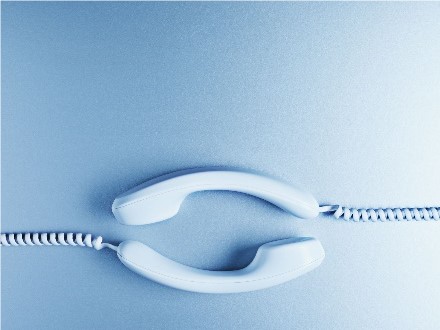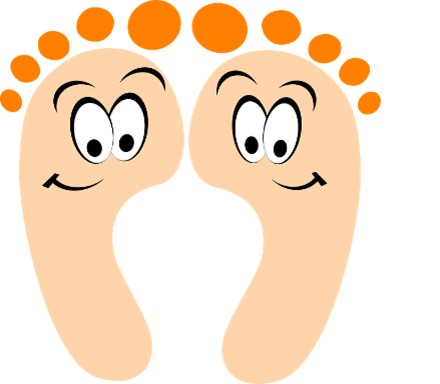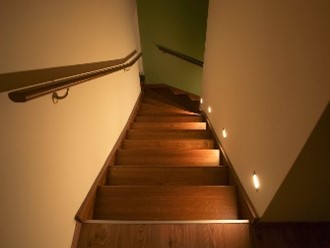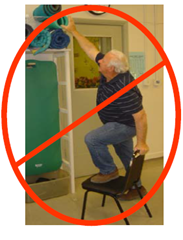Preventing Falls in Your Home
Falls are the leading cause of injury for adults 65 years and older. Over 14 million, or one in four older adults (25%), report falling yearly. This number increases to two in five (40%) for adults 85 and older. Falls are the most common cause of injury and death for older adults. They can result in more than three million injuries treated in emergency departments annually and result in surgery, hospitalization or disabilities.
Older adult falls data provided by the Centers for Disease Control (CDC) indicates that a hip fracture is one serious consequence of falling. Provisional data from 2023 points to more than 300,000 older adults who experience hip fractures each year, less than half (50%) return to full function, and 30% of hip fracture survivors require long-term care. Incidents of emergency room visits, hospitalizations and deaths increase among older adults living in rural areas and among those aged 85 years and older.
Most often, accidental falls are due to overlooked hazards, like a spill on the floor, but they are easily fixed. Being aware of these environmental risk factors or making changes can reduce your risk of having an accidental fall.
How can you reduce your risk at home?
Falls are the number one cause of preventable injury-related deaths for those 65 and older, according to the CDC. Falls pose a significant threat not only to the health but also to the independence of older Americans. Based on a July 2024 report, the CDC showed that one out of four older adults have experienced at least one fall. The number of older adults who die from falls, 41,000 or just over 112 each day, is expected to nearly double by 2030. The current estimated medical cost of falls to our healthcare system is $50 billion a year.
Falls often result in traumatic brain injuries or hip fractures and vary in severity. A mild fall can affect mobility and activities of daily living or ADLs as they are often called. Even without injury, older adults become afraid of falling, which increases their risk further and causes them to cut down on their everyday activities. Decreased activity weakens muscles and increases the risk of falling (again).
While falling is not uncommon, it is also not a normal part of aging. Falls can be prevented. Here are some suggestions you might consider making to decrease the chances of you or your loved ones being impacted by a fall:
 Talk openly with your family and your healthcare provider. Only 37% of older adults ask their healthcare provider about falls, and yet these professionals are very skilled at helping to assess fall risk and why that risk may be increasing. More than 90% of older adults see a doctor at least once a year. A regular office visit is an appropriate time to discuss if you have fallen within the past year, feel unsteady when walking or worry about falling.
Talk openly with your family and your healthcare provider. Only 37% of older adults ask their healthcare provider about falls, and yet these professionals are very skilled at helping to assess fall risk and why that risk may be increasing. More than 90% of older adults see a doctor at least once a year. A regular office visit is an appropriate time to discuss if you have fallen within the past year, feel unsteady when walking or worry about falling.
Take the Stay Independent Questionnaire. Before you go to the doctor, complete the CDC’s Stay Independent Questionnaire. Answer each of the 12 questions and total your score. Take the results to your next medical appointment so your healthcare provider can help create a personalized fall prevention plan. This helps you take health literacy or knowledge into your own hands.
Have your eyes, ears and feet checked. Conditions such as glaucoma and cataracts limit vision and increase the chances of falling. Cleaning your eyeglasses daily is also a good practice. Hearing loss can result in balance issues, causing you to be unstable. Foot conditions and improper footwear can also contribute to falls. Choose close-toed walkable shoes that fit correctly with comfortable socks. Visit a podiatrist or diabetic educator to learn more about proper foot care.
Keep an updated list of all your medications and have it reviewed periodically. Four out of five older adults take at least one prescription medication each day, and more than one-third take five or more daily. While medications are taken to improve sleep, blood pressure, mental health or chronic pain, the side effects from these could result in a fall. Medications often change the way you feel or think, and when a new medication is prescribed, it may increase your risk of falling. As you get older, medications change, and medicines also change the way they affect your body (similar to food and drinks). Look for changes in vision, concentration, muscle strength, balance, reaction time, alertness, fainting, sleepiness or blood pressure. Ask your provider about vitamin D supplements to improve bone, muscle and nerve health. Visit the University of Nevada, Reno Sanford Center for Aging’s Medical Therapy Management program to review your prescribed and over-the-counter medication and supplements.

Make your home safer:
- Minimize clutter and tripping hazards from stairs and places where you walk.
- Remove small rugs or use double-sided tape to secure them.
- Keep items you use often within easy reach (avoiding the need for stepping stools).
- Place grab bars inside and outside the tub, shower or toilet area; use non-slip mats.
- Have handrails and lights installed on all staircases.
- Improve the lighting and have someone replace the light bulbs when needed.
- Check your home for hazards that might cause you to trip, slip or fall.
- Look at the entranceways to your home for proper lighting.
- When you spot a safety hazard, correct it as soon as possible.
- Keep large print and emergency numbers near each landline phone in your home.
- Have a mobile phone near you at all times in case you fall and cannot get up.
- Ask someone to pre-program emergency phone numbers on your phone to speed dial.
- Consider wearing an alarm device that you can use to call for help.
- Establish a daily “buddy check” system with a neighbor.
For additional ideas, review the Stopping Elderly Accidents, Deaths and Injuries or STEADI safety checklist.
Exercise to improve your balance, the center of gravity, and strength. The balance of your center of gravity is important. It can be disrupted outwardly by slipping and tripping due to an unsafe environment or within, such as by weak muscles and poor strength, throwing off our balance and causing us to fall. Overall, women fall more than men, partly due to a greater lack of strength. Improving muscle strength, mass, postural control, balance and coordination can prevent a fall or minimize its severity.
Despite knowing the benefits of physical activity related to chronic disease and physical function as we age, only 27% of older adults meet the recommended physical activity guidelines. The latest Physical Activity Guidelines for Americans Scientific Report published in 2018 by the Department of Health and Human Services provides compelling evidence that physical activity reduces the risk of fall-related injuries in older adults by 32 to 40%, and that using various modes or combinations of physical activity provides the most benefits. Recommended activities include resistance or muscle strength training; cardio-endurance or aerobic activities, such as walking or dancing; and balance activities, such as Tai Chi, Pilates or Yoga. One or more combinations of these exercises will improve strength, balance, gait speed and improve ADLs.
If you are at minimal risk for falls and want to decrease your risk of falling later in life, try a simple chair exercise at home. Repeated standing and sitting will strengthen your legs and buttocks. Activities like this one may delay your risks and increase your independence as you age.
The CDC’s STEADI initiative website provides additional free materials, checklists and suggestions. The good news is, according to the CDC, implementing just a single fall intervention, such as medication management, home modification or an exercise program, could prevent falls. It is never too late to start.
Provide Adequate Lighting
 Vision changes occur with aging. Older adults require up to three times more light to see well and their eyes do not adjust as quickly to changes in light conditions, such as those experienced when walking from a brightly lit room to a darker room.
Vision changes occur with aging. Older adults require up to three times more light to see well and their eyes do not adjust as quickly to changes in light conditions, such as those experienced when walking from a brightly lit room to a darker room.
- Keep lights on in the rooms you are using or walking through; it is not an extravagant expense when considering this safety technique helps you avoid falling.
- Create consistent lighting that is free of shadows and glare. If lights cause glare, try frosted bulbs.
- Keep outside entrances lit for when you come home or so you can see visitors at the door.
- During the day, open the curtains and shades to let in more sunlight. If glare is a problem, try opening them only partially.
- Are your lamps working? Do light bulbs need to be replaced? Is there a working light switch to light a room at each entrance? Consider additional lamps and use a nightlight for dark passageways and rooms frequented at night (e.g., bedrooms, bathrooms, hallways).
Clear Loose Objects & Clutter from the Floor
- Keep things off the floor like magazines, books, shoes, boxes or other cluttered objects.
- Anything blocking passageways through a room or hallway should be removed, including walkers, canes, wheelchairs, and oxygen tubing.
- Furniture placement should be designed to assist with balance and create ease of movement within a room.
Check Electrical & Phone Cords
- Electrical and phone cords should be set against a wall, or behind furniture, where people can't trip over them.
- Watch for vacuum cleaner (or any household electrical item) cords that may get in the way during use. Also watch for dog leashes, garden hoses or even oxygen tubes!
Remove or Secure Loose Area Rugs
- LOOSE RUGS, runners, or mats in all areas of your home SHOULD BE REMOVED. They catch heels and toes and cause many in-home falls.
- If you choose to use rugs, particularly in the bathroom, kitchen, and bedrooms, check them for slip resistance. Always secure rugs using double-sided adhesive carpet tape or rubber matting. Check them often for wear and tear and replace tape or backing when needed.
Watch for Slippery Substances
- Be careful in the kitchen, bathroom and laundry area where water might be splashed from a sink or other source.
- Floors in these areas should be easy to care for and slip-resistant when wet. Avoid waxing floors and clean up water and other spills immediately.
Safety Proof Your Bedroom & Bathroom
- Lamps and/or switches should be easily reachable near doors and the bed.
- Rearrange furniture to create clear passageways.
- Use a night light, especially one that comes on automatically when it gets dark (consider a flashlight on the bedside table).
Avoid Falls in the Shower or Tub
- Install grab bars (Never substitute with a towel bar!)
- Use shower seats or transfer benches when needed.
- Place non-skid strips or decals in the tub or shower.
- Secure tub mats if used.
Avoid Kitchen/Garage/Storage/Repair Hazards
Store cabinet, closet or shelf items that you use often on a level where they are easily reached.
- STANDING ON A CHAIR or some other makeshift stool is DANGEROUS. Consider buying a stepstool, particularly one with handrails. Make sure the stepstool is fully open and stable before you climb onto it. Tighten any screws or braces and get rid of stepstools with broken parts. Always wear proper footwear when using stepstools or ladders.
- Consider buying a reach extender (grabber), a long rod with a gripper on the end that you control with a lever. This may be helpful for reaching light/medium-weight items.
- Do not attempt to do activities you are unsure about, like standing on a ladder to change a light bulb. Ask for help from a neighbor or friend. Don’t risk an injury from a fall!
Safeguard Stairs & Steps
Every day, older adults trip on stairs they know well. Both in and outside your home, always remember to:
- Use handrails for support. Install handrails at home if you don’t have them (on both sides if possible) and/or fix them
if not secure to the wall.
- Have adequate lighting both inside and outside. At home, light switches, operating flashlights, or nearby nightlights should be at the top and bottom of stairways.
- Look for objects that might be on the stairway. Don’t store items on stair steps.
- Paint or use colored duct tape on the edge of each stair in a color that contrasts with the color of the stairs to help you see where one stair ends and the next starts.
- Always pay attention to your surroundings and slow down - being in a hurry can cause accidents!
Outside of the Home, Be Cautious of:
- Uneven pavement or sidewalks, loose gravel or rocks, or curb height differences.
- Unfamiliar surroundings, especially at night.
- Unexpected spills on the garage floor or walkways and driveways.
- Loose objects obstructing pathways can interfere with our balance and stability.
- Slippery areas, especially areas affected by inclement weather, rubber mats and outdoor equipment are potential fall hazards.
References
- Nonfatal and Fatal Falls Among Adults Aged ≥65 Years — United States, 2020–2021. CDC Morbidity and Mortality Weekly Report, 2023. [Accessed 7/17/24].
- Hip Fracture-Related Emergency Department Visits, Hospitalizations and Deaths by Mechanism of Injury among Adults Aged 65 and Older, United States 2019. National Library of Medicine, 2022. [Accessed 7/17/24].
- Falls: No laughing matter: Take steps to minimize the risk of injury due to falls. Nevada Today, NSights, 2020. [Accessed 7/17/24].
- Check for Safety: A Home Fall Prevention Checklist for Older Adults. CDC and STEADI brochure, 2017.
- Preventing Falls at Home: Room by Room. National Institute of Aging, September 2022.
- U.S. Consumer Product Safety Commission, October 2004. Safety for Older Consumers: Home Safety Checklist (CPSC Document #701). [Accessed 8/27/24].


